The Constitution of India is the supreme law of the land. It is we the people of India, who by giving ourselves this Constitution on the 26th of November 1949, and bringing it into effect on the 26th of January 1950, laid the cornerstone of the world’s largest and most vibrant democracy. 26th November is celebrated as Constitution Day while 26th January is celebrated as Republic Day.
Join Cultural Samvaad’s WhatsApp community
The original manuscripts of our Constitution in English and Hindi were handcrafted. The exquisite calligraphy of Shri Prem Bihari Narain Raizada in the English version and the intricate and stunning illuminated art works and borders created by Shri Nandalal Bose and his students from Shanti Niketan not only made the pathbreaking document a visual delight for generations but also ensured that the Constitution provided a glimpse into the rich culture, varied heritage and illustrious past of India that is Bharat.
Understand the Basic Features of the Constitution of India
The Constitution commences with an illustration of our National Emblem and the slogan – ‘Satyameva Jayate’ or Truth Alone Triumphs. The National Emblem has been adopted from the Mauryan Emperor Ashoka’s famous Lion Capital at Sarnath and is a symbol of pride for every Indian.
Each of the 22 parts of the Constitution of India were illustrated and these 22 outstanding paintings encompass an unimaginable period of time, subjects and artistic styles.
Seal from the Indus Valley Civilisation
A seal with an impressive zebu bull and a short inscription in the undeciphered script of our early ancestors from the pioneering Harappan or Indus-Saraswati civilisation adorns the opening page of Part I – The Union and its Territory.
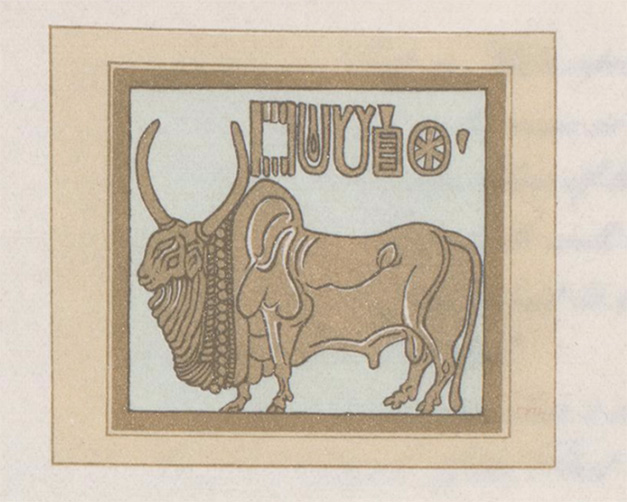
A Gurukul – An Integral Part of the Indic Education System
Part II of the Constitution which deals with Citizenship is decorated with an evocative illustration of a Gurukul in a rishi’s ashram – that hallowed portal of learning whose origins can be traced back to the Vedas.

Ramayana or Ramakatha – The National Epic of India
Shri Rama, Devi Sita and Shri Lakshman – the eternal heroes of India who symbolise the victory of dharma over adharma[i] are depicted in a scene from the Ramayana in Part III – Fundamental Rights.
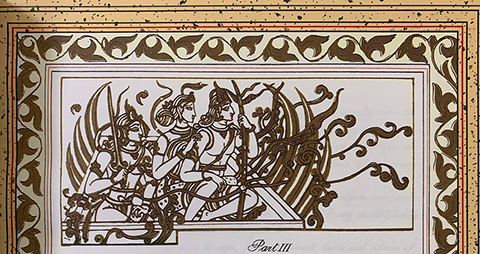
Bhagavad Gita – The Most Famouns Song of India
Shri Krishna propounding the infinite ocean of wisdom – the Bhagavat Gita to a kimkartavyavimoodh[ii] Arjuna before the commencement of the battle of Mahabharat at Kurukshetra is the subject of the artwork in Part IV – Directive Principles of State Policy.
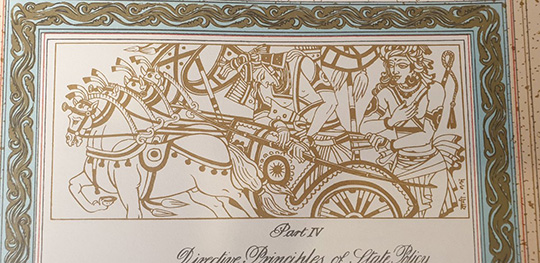
Gautam Buddha Turns the Wheel of Dharma – His First Sermon
An exquisite illustration of the enlightened Gautam Buddha delivering his trailblazing first sermon – the Dharmachakra Pravartana Sutra embellishes Part V of the Constitution dedicated to the Union.
Mahavira Swami – An Apostle of Non-violence
Part VI of the Constitution commences with a richly coloured piece of art of the meditating Vardhamana Mahavira – a paragon of non-violence and the last Tirthankara of our times.
The Spread of Buddhism – Ashoka’s Mission
Ashoka’s mission and his efforts to ensure that the word and the message of the Buddha travelled far and wide are depicted in an intricate piece in Part VII of the Constitution.
Multifarious objects including an early temple-like structure, a graceful and adorned flying yaksha and richly illustrated flora blend together in the image in Part VIII which is characteristic of the style of the golden Gupta period.
Artistic impressions of the magnificent and lively court of King Vikramaditya and an iconic coin issued by him adorn the first page of Part IX of our Constitution.
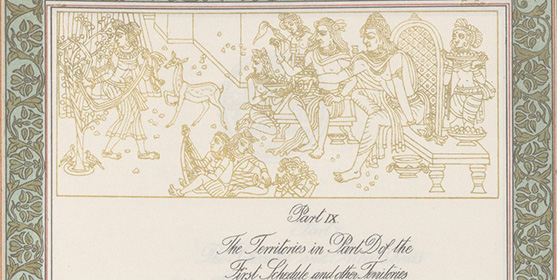
One of ancient India’s most famous universities – the Nalanda Mahavihara which was a global centre of education and learning for over 800 years and is now also a UNESCO World Heritage Site is depicted in Part X.
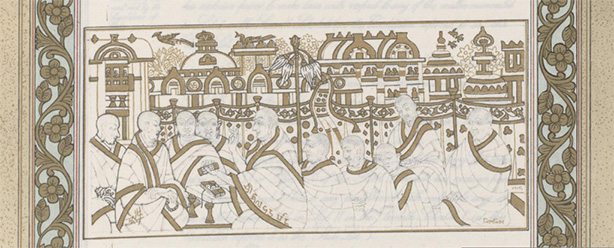
An exquisite composition in Part XI of the Constitution which includes a graceful horse and other figures is a tribute to the ingenuity of the great artists of Odisha.

A representation of the brilliant and all-pervading Shiva Nataraja engaged in his cosmic dance and reminiscent of the grand Chola bronze sculptures adorns Part XII of our Constitution.
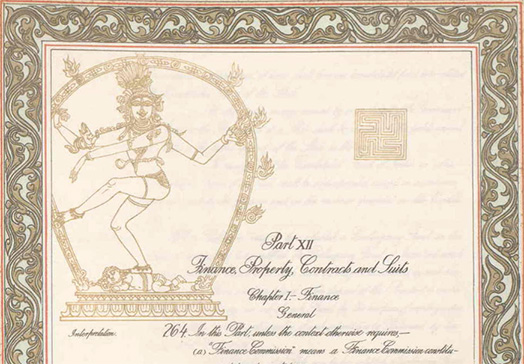
The Great Mahabalipuram Relief – Arjuna’s Penance or the Descent of the Ganga
The enigmatic, humungous Pallava bas relief at Mamallapuram which depicts either the descent of the Ganga or Arjuna’s penance is portrayed in Part XIII. This bas relief forms a part of the Group of Monuments at Mahabilapuram or Mamallapuram which is a UNESCO World Heritage Site.
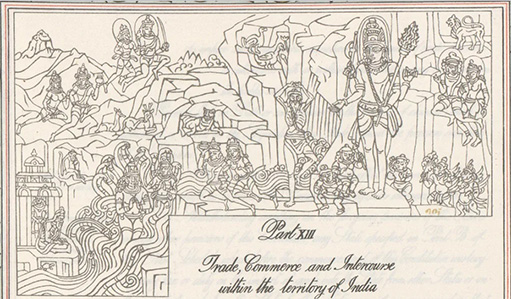
Part XIV – Services under the Union and the States commences with a scene from the court of Emperor Akbar in which imposing masterpieces of Mughal architecture serve as a backdrop.
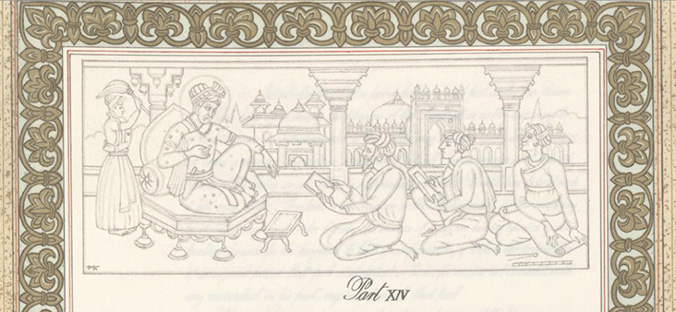
The valiant and great Maratha King – Chhatrapati Shivaji Maharaj and the dauntless, last Guru in the Sikh tradition – Guru Gobind Singhji who established the Khalsa occupy a place of pride in Part XV which deals with Elections.
Khoob ladi mardani woh toh Jhansi wali rani thi. The indomitable Rani Lakshmibai and the king of Mysore – Tipu Sultan, two leaders who were instrumental in India’s early freedom struggle feature in Part XVI.

Two iconic illustrations of Mahatma Gandhi in Part XVII and Part XVIII of our Constitution are a humble tribute to his role in India’s struggle for independence.
Netaji Subhash Chandra Bose
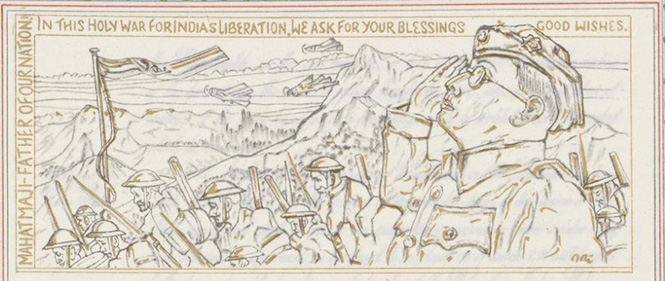
The gallant Netaji Subhash Chandra Bose and his fellow patriots adorn Part XIX of our Constitution as a nation’s homage to the great revolutionaries who powered the Indian freedom movement.
India that is Bharat boasts of unparalleled natural heritage. Stunning and evocative artworks that depict the proud and majestic Himalayas and the silent and vast desert sands are showcased in Parts XX and XXI of our Constitution respectively.
The boats depicted in Part XXII of our Constitution not only remind us of the unending oceans that make Hindustan saare jahan se accha but also symbolise the eternal quest of we the people to sail beyond the limitations of our ordinary faculties.
The 22 pieces of art that embellish our Constitution are by very definition not exhaustive in nature but when woven together in this document of unparalleled importance bring to life a captivating portrait of the diverse culture and timeless civilisation of India that is Bharat.
Jai Hind.
Endnotes
[i] Commonly translated as good over evil
[ii] A Sanskrit term which implies that the subject is nonplussed and cannot decide her/his future course of action



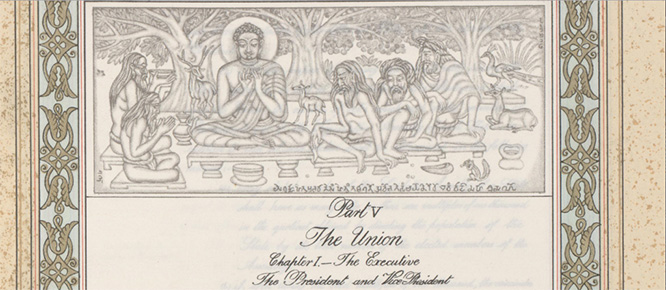
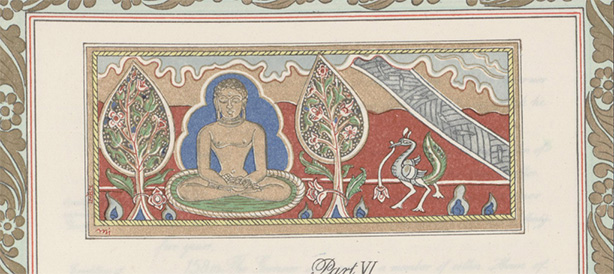

Respect to Indian Heritage placed in constitution of India !!!
Thanks and gratitude
I have come to know deep reverence paid to our spritual and patriotic leaders in our constitution so artistically
New generation should get such heritage in there acknowledge as they are running behind western culture mostly
Very good information which gave me strength to know about the constitution and our heritage.
Send such good information articles and our cultural diversity